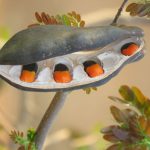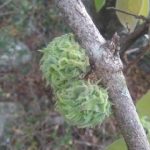Tree Life
November 2021
Hi Everyone,
Welcome to this issue of Tree Life. For your information and planning the following are key dates to note for November:
- Botanical Gardens Walk Saturday 6 November 8.30am to 10.00 am.
- 4th Saturday Keith and Jeanette Nicholson at 6 Princes’ Close off Piers Road, Borrowdale to start at 2.30 pm.
- At the moment it is not planned to have a Christmas Party in December and this get-together will be combined with the AGM to be held next year. Details to follow.
If any other outings are arranged, you will be informed directly by our Chairman Tony Alegria.
Going forward the Committee will be setting up a Tree Society WhatsApp Group to help publicise activities and important notices. This will be used exclusively for Tree Society business and not for any irrelevant information. There are many other groups where the exchange of non-tree related information can be done. At the same time e-mail will continue to be used to send out notices and newsletters.
Contributions to the Tree Life newsletter are very welcome and we ask that any and all of you are encouraged to do contributions from time to time if you have a favourite tree, or you may see something special in your travels either around the country or perhaps even externally. Ideally contributions should be around an A4 page size, including photographs, but if you have a really good story, longer articles can be entertained.
Cheers Mafungi

Diospyros mespiliformis Photo by Rob Jarvis
Tree of the Month
There is no doubt that one of the most spectacular trees in our bushveld is the jackal berry. We are most likely to encounter them at the edge of a pan or riverbank area in one of our national parks and we were recently encamped under a grove of them at Machiniwa pan in the northern section of Gona re zhou National Park. We later moved to the southern end and met them again and found ourselves parked under the beautiful pair seen above on the edge of Centre Pan some 30 kilometres or so from Simulwini Lodges along the Mwenezi River. They are members of the Family Ebenaceae and are called African ebony as well. The yellow fleshy fruit is oval and is much sought after by wildlife and mankind. When fully ripe the fruit turns a deep purple but the depredation of animal life means that you will rarely see them this colour.
Whilst we were parked at the Centre Pan we saw a vast array of birdlife use these trees to perch in before and after drinking down at the pan’s edge. In the late evening thousands of swallows came and were swirling around the trees, our car and an anthill trying to look for respite from an icy wind that had started blowing in from the southeast the day before. A large number of them found shelter on a ledge formed by two closely growing branches on the slanting tree in the photograph above. Many others were sheltering in our wheel arches on the leeward side of the vehicle.
They are called jackal berry because their seed is often found in the dung of jackals, and almost every other mammal you can think of that might eat fruit.
The trees are widespread throughout Africa and a huge amount of uses can be found for the wood, sap, the roots seem especially good at providing extracts for parasites, gut diseases and even fever. They are termite proof.

Lala palms Photo by Rob Jarvis
Trees of Gona re Zhou by Rob Jarvis
Lala palm
Hyphaene petersiana Mart.
Gona re Zhou is well-endowed with quite stunning natural woodlands consisting almost exclusively of this majestic palm. The fruits are much sought after by elephant in particular and despite the reportedly very large populations of elephant in this particular National Park, cited by experts as being 2 to 3 times the expected carrying capacity of the area, the palms are in good heart. We saw a number of very young, recently germinated plants growing in and around these woodlands and there were quite numerous groups of intermediate-sized palms that were awaiting the signal to send their apical stem skywards once the base had been well-established.
Surprisingly we also saw some young palms growing out of the bases of older trees. Quite how they germinated on the hard fibrous hard woody bases is not easily explained. We also saw a number that had split mainstems and giving the resultant tree an outline resembling a tall wine glass from a distance. Presumably some insect or physical damage to the apical stem resulted in this splitting.
These palms are known as vegetable ivory because of the colour and appearance of the nut inside the tough seed coat. In many parts of Africa, but Mozambique in particular these palms, have their hearts tapped to get a juice to brew wine.

Young palms growing from the fibrous stems of an older plant Photo Rob Jarvis

The Itching Post Photo by Rob Jarvis
It’s Jacaranda Time Again!
by Tony Alegria
The Jacaranda mimosifolia is a genus of 49 species of flowering plants in the family Bignoniaceae, which is native to Brazil and surrounding countries. Jacaranda mimosifolia (Common name – Blue jacaranda) is the species known in Zimbabwe but they certainly don’t look like they have blue flowers – purple, lilac or mauve is more like it! But, there is also a variant of the Jacaranda mimosifolia which has white flowers. October is the month when Harare Avenues and many suburbs have the Jacaranda trees at their flowering peak. These were planted mainly as street trees but there are a huge number of them planted in gardens as well. Jacarandas will flower for about six months of the year with the last flowers still to be seen in January.
According to various articles on the internet, the first jacarandas to be planted in Fort Salisbury, as it was known in those days, were brought in from the botanical gardens in Durban by a honeymooning couple who brought in six seedlings way back in 1899. The articles also state that the first tree was planted late in 1899 or early in 1900 and was seen flowering in 1908. However nothing is mentioned about what happened to the other five seedlings. The tree was planted in a garden at number 13 Cape Ave, which subsequently became Montague Avenue. Since then there has been a number and street name change – the property is now no: 23 Josiah Chinamano Avenue. In 1987 the old house was replaced by a building with flats appropriately named Jacaranda Mews. The tree collapsed in 1998 when it was almost 100 years old.
The white jacaranda in all respects is exactly the same as the purple variety in terms of foliage, bark and pods. The difference, apart from the white flowers, is that it appears to be a bit smaller than any nearby jacarandas.

White jacaranda tree Photo by Dave Hartung
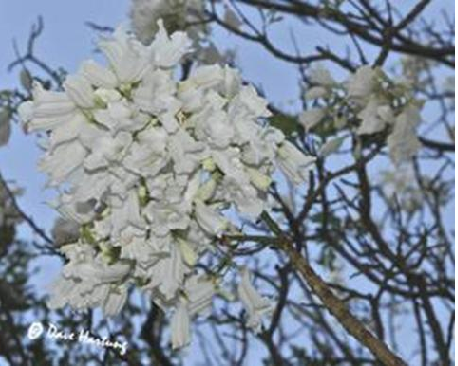
White jacaranda flowers Photo by Dave Hartung
There are a few white jacarandas which can be seen from the road in Harare as listed below:
Alexandra Park: One street tree at No. 9, Bantry Road.
Avenues: One street tree at No. 155, Baines Ave. between Sixth and Seventh Streets.
Belvedere North: Two street trees, with one purple in-between them along Samora Machel opposite the Tel-One College. They are in front of properties Nos. 148 & 152, Samora Machel Ave.
Borrowdale: One street tree on Piers Road opposite Bon Marche in Sam Levy’s Village.
Borrowdale: One garden tree in No. 319, Gough Close.
Colne Valley: One garden tree in No.195, Enterprise Road opposite the Chisipite shopping centre.
Glen Lorne: Two small street trees at No. 16, Manyonga Close.
Harare Gardens: One tree behind Livingstone House.
Mount Pleasant: One street tree at No. 41, Coull Drive.
Valencedene: One small street tree at No. 13, Roy Road.
No doubt there are many more white jacarandas in Harare and elsewhere within Zimbabwe. If you know of the location of any white jacarandas which are visible from the road, apart from those listed above, kindly let us know.
THE SCREW PINE
By Mary Toet
The Screw Pine has many interesting and unusual features. It is often mistakenly called the Screw Palm. The plants are dioecious and have male and female flowers on separate trees.
The specimen in the photograph is at Dandaro retirement Village at Borrowdale, Harare, Zimbabwe.
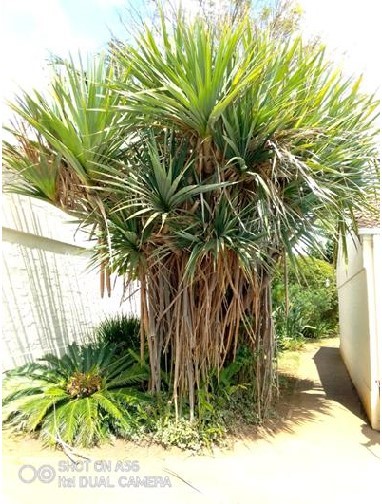
Pandanus utilis Photo by Mary Toet
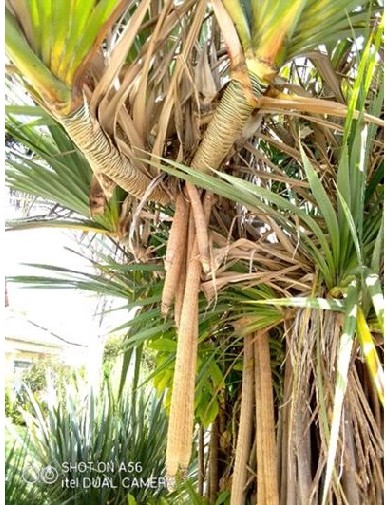
Pandanus utilis Photo by Mary Toet
The Latin name is Pandanus utilis and there are 600-700 species worldwide. It is sought after as a horticultural plant and grows in warm tropical seas from Florida to Japan and Madagascar. Its distribution is limited by the seeds that only germinate at 27o C.
The name “Screw” comes from the scars encircling the stems. These are in a giant swirly pattern from which the common name is derived. The word ‘pine’ is derived from the pineapple like fruits produced on a female plant.
The leaves have a spongy tissue and have as many as 150 fibres. They can take 3 to 4 months to develop. The male cones produce microspores and occur on the lower branches whereas the female cones are produced on the upper branches. After pollination, fertilisation can take up to 2 years. Time does not seem to matter to these ancient plants that diverged after the breakup of Gondwanaland. The seeds develop in sandy ground.
The prop roots are adventitious roots developing from the heavy stems and supporting their weight. Prop roots occur on maize plants and are common but have different functions under different ecological conditions. L Jeebit Singh former Agricultural Officer gives the differences between stilt roots and prop roots as follows:
- Prop roots develop from the upper part of the stem, especially the horizontal branches while stilt roots develop from the basal nodes of the main stem.
- Prop roots are quite long while stilt roots are comparatively short.
- Prop roots pass down into the soil in a vertical position while stilt roots develop obliquely at an angle to the stem.
- Prop roots provide support to the plant like pillars or poles while stilt roots provide support like ropes of a tent or pole.
- Young prop roots are hygroscopic while young; stilt roots are non-hygroscopic.
- Prop roots are quite thick and massive while stilt roots are comparatively little..
- Prop roots can replace the trunk or main stem while the stilt roots seldom replace the main stem”
The hygroscopic massive prop roots derive water from sea spray or seasonal rain. The stilt roots in the photograph have shown that some have developed from broken prop roots and not from the main stem. These stilt roots probably help to stabilize the plant against wind. During the day and night there will be offshore and sea breezes. During the monsoon seasons there are very strong winds. The Southern Hemisphere Spring Equinox occurred in Harare on the 22nd of September 2021. The Equinoxes produce neap and leap tides. These tides carve out banks on which the screw pine grows.

Screw pine holding down sand Photo by Mary Toet
The screw pine at Watamu is not just a shady retreat for the beachcomber but holds the embankment. Casuarinas precariously hold the spring tide embankment.
Coates Palgrave writes Casuarina equisetifolia was introduced to southern Africa from the Far East and Australia. It has been used to stabilize shifting sand at the coast and has escaped in parts of KwaZulu-Natal and Mozambique but it is not yet considered a pest plant. This just indicates how successful this plant along with the Screw Pine has been in the littoral zones. The casuarina is a dicotyledon while the Screw Pine is a monocotyledon; these terms referring to the number of cotyledons in the seed.
The Screw Pine because of its adventitious roots will propagate vegetatively if pieces of heavy branch are tossed by the sea onto favourable growing conditions. The leaves are folded in a spiral and are gutter-like to direct water to the prop roots. The flow of water is carried by a network of aqueducts.
Economically the Screw Pine is considered second to the coconut in importance. The resin and fibres are strong and biodegradable and are made into paper and baskets by the indigenous people. The male inflorescences are considered to be an aphrodisiac.

Pandanus utilis root protective spines Photo by Mary Toet
Commercially the root fibres have tensile properties, impact strength and water absorption (ASTM). The Chinese have extensively researched and used this root material to reinforce building material.
Old prop roots showing protective spines. The larger prop root is breaking up and showing its fibrous composition.
The younger root shows the lines where the water flows down its surface. Water is stored in absorbing tissue surrounding the root tip. Indiscriminate cutting of the prop roots will result in destroying the plant. There is a tendency for horticulturists to prune indiscriminately.
The life cycle of these plants to conquer sand, sea, tide and wind is continuous. Their ability to withstand adverse conditions makes them noteworthy in many aspects, both as ecological colonizers and of economic considerations.
Books to watch out for:
At the Good Food Fair in the National Botanic Gardens I was tempted by the Newton Spicer to purchase a copy of the Acacia Handbook below left. Apparently this is an updated reprint and given the wonderful role that Acacias, (Vachellias, Senegalias) play in the African ecosystem right across the length and breadth of the continent, it really should be in everyone’s book shelf.
Below right is the recently published Tree Tales of Zimbabwe, by Jonathan Waters and equally this book deserves pride of place right next to your copy of Historic Trees of Zimbabwe written by the late Lynn Mullins. In fact many of the trees that Mullins collected information on but did not feature in his book were given a lease on life by being included in this lovely book.
The Acacia Handbook can be definitely found at the Forestry Commission on Orange Grove Drive for US$20 per copy and the Tree Tales of Zimbabwe should be in all leading bookstores at US$30 each.
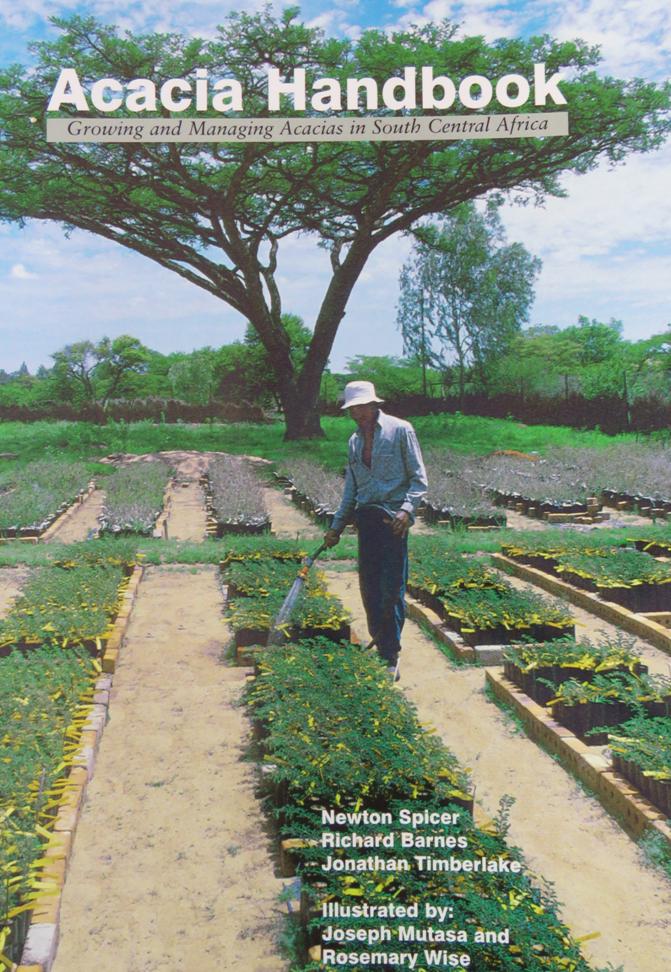
Acacia handbook Photo by Rob Jarvis

Tree Tales of Zimbabwe Photo by Rob Jarvis
In closing this issue of Tree Life we show you a picture of a fallen behemoth on the road between timbavata and machiniwa Pans in the northern section of gone re Zhou National park. Baobabs are probably the quickest tree of all to return to dust and I am sure that by the time this coming rainy season is well and truly over, there will be nothing left of this once-magnificent tree. Undoubtedly it had many a tale to tell and even now in death a family of warthog have burrowed underneath and made a temporary shelter. As the tree rots it serves as a substrate to multiple species of fungi and other micro-organisms and insects, millipedes and the like that will, in a few short months leave absolutely no evidence that here, once stood a tree!

Remnants of a baobab Photo by Rob Jarvis
However time moves on and the nutrients released by this process of decay will undoubtedly allow new vegetation to thrive. Of concern wherever pachyderms are the main herbivores feeding on baobabs, is the lack of succession trees of the same species. In fact even baboons are known to rip off young baobabs and chew the juicy swollen root of a young tree. Unfortunately the rains and the swollen Save and Rhunde Rivers will not allow passage to check this tree and by the time we get back it will be all over. If only we could be as tidy in sorting out our own lives at the end!
Cheers Mafungi
Chairman, Tony Alegria


